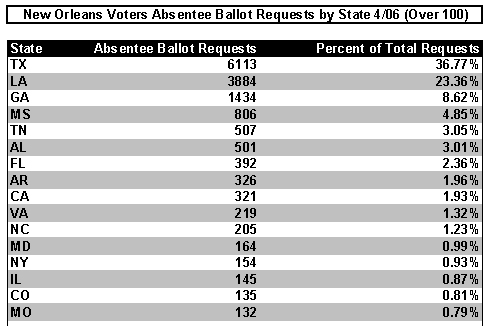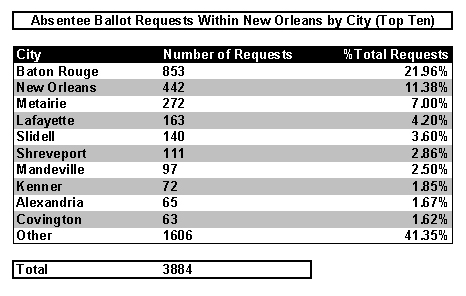New Orleans Absentee Ballot Requests - April 2006
With the massive displacement of New Orleans voters caused by Hurricane
Katrina, Louisiana state officials made an exception for displaced,
first-time voters, permitting them to cast absentee ballots in this
election. Under normal circumstances, state law required one to vote in
person when voting for the first time. Currently, over 16,600 voters
have requested absentee ballots, with over 37% of the requests coming
from Texas and 23% coming from voters who have moved from one part of
Louisiana to another. The total turnout in 2002 was well over 115,000,
meaning that if turnout decreases as expected, absentee voters will
make up an unprecedented percentage of the total voting population.New Orleans, notably, uses a two-round runoff system for mayor and council elections. If no candidate receives a majority of votes, the top two candidates (regardless of party affiliation) face each other in a May 20th runoff round – one that could include a relatively low-percentage candidate given the large field and that exclude a strong candidate who finishes third. The first round is called a “cajun primary.” All candidates of all parties run on the same ballot; there is no nomination process.
Absentee voters disenfranchised in the runoff round: The combination of runoff elections and an unprecedented number of absentee voters means many voters could be disenfranchised in the runoff round. In the 2002 election, both the District A and mayoral races went to runoffs. Because the second round occurs a month after the first, administrators have three weeks to figure out which candidates will be on the second round ballot, print new ballots, and then mail them to about 16,600 absentee ballots from voters around the country. Voters have even less time to return them. One solution to this problem is to allow absentee voters to cast both their first and second round ballots at one time, using a ranked ballot system. Such a method is currently used successfully for military and overseas absentee voters from Louisiana. For more information click [HERE].
Notably, of the over 16,600 absentee ballot requests, most came from only a handful of neighboring states. Tables 1, 2, and 3 below indicate the number of absentee ballots requested sorted by state. Texas had a whopping number of requests when compared with the rest of the nation, but many requests came from within Louisiana. Of these voters 3,884 who stayed within the state, many have relocated to Baton Rouge and other major Louisiana cities, but approximately 11% of the Louisiana absentee ballot requests came from with the city of New Orleans itself. This indicates that a large number of people have requested ballots to vote in their destroyed home precincts, even though they now live in a different part of the city. How long the city will continue to conduct elections in this manner is unknown, but there remain a great number of hurdles to ensuring the voting rights of Hurricane Katrina victims are not jeapordized by the displacement. FairVote suggests a number of reforms [HERE].
Table 1.

Table 2.

Table 3.

Table 4.

The Winner-Take-All Problem
“Winner-take-all” is a term used to describe single member district and
at large election systems that award seats to the highest vote getters
without ensuring fair representation for minority groups. In the United
States, these are typically single-member district schemes or at-large,
block-voting systems. Under winner-take-all rules, a slim majority of
voters can control 100% of seats, leaving everyone else effectively
without representation. Problems this leads to include:- Severe under-representation of women, communities of color, third parties, young people, and major party backers stuck in areas where another party dominates. Winner-take-all election systems do nothing to provide representation to any group making up less than half of the population in a given voting district, and the high percentage of the vote needed to win election can be a severe barrier to minority candidates.
- Since many areas are dominated by a single political viewpoint, winner-take-all voting systems will often result in no-choice elections where one party has a permanent monopoly on power, and the winner is effectively predetermined. In the United States, two in five state legislative races go uncontested as a result, and nearly 99% of congressional incumbents win reelection by large margins.
- High percentages of “wasted votes” (that is, votes cast for candidates who do not win). Winner-take-all elections frequently result in more than 50% of votes being wasted. More voters will be represented by someone who they did not help to elect than under any other system.
- Undervoting.
Under at-large systems in particular, voters who feel strongly about a
single candidate will be likely to “bullet vote” (that is, use only one
of their votes) to help their preferred choice win election. In this
way, winner-take-all discourages voters from expressing their full
range of political preferences.
- Decreased voter turnout. With limited choice, and little chance of influencing the outcome of an election under winner-take-all rules, many people will unsurprisingly choose not to participate.
- Divisive campaigns that fail to address challenging issues and ignore entire constituencies. Under winner-take-all, there is no incentive to reach out to opponents or build cross-party support. Negative campaigning is often a sensible and effective strategy.
[more]